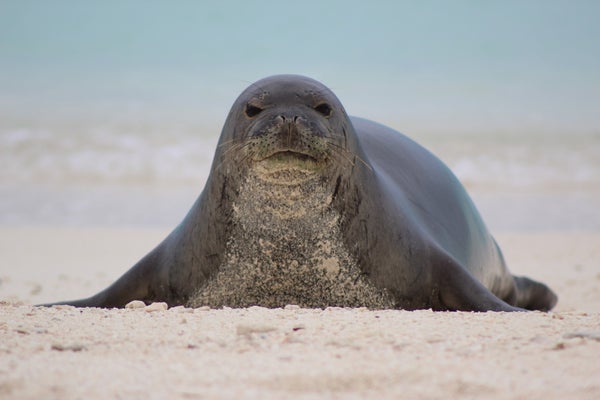This article was published in Scientific American’s former blog network and reflects the views of the author, not necessarily those of Scientific American
Understanding the social networks of critically endangered Hawaiian monk seals (Neomonachus schauinslandi) could help to save the species from extinction.
No, we’re not talking about Facebook or Twitter, but connections, likes and shares still comes into play. You see, new research reveals that Hawaiian monk seals have well-established and predictable patterns of social behavior and contact. Figuring out which seals are likely to connect and share with each other also helps to identify which animals are mostly likely to spread potentially deadly diseases into the broader population.
Those diseases haven’t hit Hawaiian monk seals yet, but they might not be far away. Morbilliviruses, the group of diseases that includes canine distemper, are already present on Hawaii and experts worry that they could easily make their way to the monk seals. The species has a very low genetic diversity that makes the viruses—which have killed tens of thousands of harbor seals in previous outbreaks—particularly threatening in Hawaii.
On supporting science journalism
If you're enjoying this article, consider supporting our award-winning journalism by subscribing. By purchasing a subscription you are helping to ensure the future of impactful stories about the discoveries and ideas shaping our world today.
That’s why conservationists have begun vaccinating the most social Hawaiian monk seals against a potential morbillivirus outbreak. The effort involves sneaking up on snoozing seals, jabbing them with a syringe attached to a three-foot pole, and getting out of the way of pretty darned quickly.
It’s actually easier than it sounds, says Charles Littnan, lead scientist for the National Oceanic and Atmospheric Administration’s Hawaiian Monk Seal Research Program. “We were imaging biologists racing off to save their lives after they injected these animals,” he says. Instead, the seals usually do little more than bark, give the person with the syringe a dirty look, and then go back to sleep.
“It was not as dramatic as we’d been prepared for,” LIttnan admits.
That sense of drama built up last summer when NOAA and its partners conducted a back-breaking vaccination drill on Oahu and other Hawaiian islands to see what it would take to protect monk seals if an epidemic had already started.
“That was an arduous task,” Littnan says. “The drill really drove home the logistical challenges of trying to mount an archipelago-wide effort to stem a disease which we believed would spread.” More importantly, the drill and NOAA’s research into monk seal social networks taught them that the best way to go would be preventative vaccination: building up seal immunity now, rather than waiting for the disease to arrive.
Littnan says their research revealed that there are both geographic hotspots for monk seals as well as hyper-social individuals who have strong linkages to lots of different animals. Those sites and seals became priorities for vaccination. Non-pregnant females and newly weaned pups also sit atop the priority list. “We’re finding the animals where we’ll get the most bang for the buck, either because they’re likely going to be an agent of disease spread if the disease breaks out or they are an incredibly valuable part of the population, which is every female,” he says.
As of last week, the team has vaccinated 39 seals, each of which has also received the necessary booster shot after the first injection. The booster, Littnan says, is the hardest part of the process since it involves tracking the same seals down a second time. “Finding them when that relatively narrow booster window opens is where the real art and hard work comes in,” he says. Eleven additional seals are currently awaiting their booster shots.
Littnan says the goal is not to vaccinate every single one of the Hawaii’s 1,300 monk seals. “We just need to vaccinate a certain proportion to achieve herd immunity,” he says. “It’s the exact same thing with children going to school and getting their vaccines. Not every child needs it, but if you get 80 to 90 percent vaccinated, it creates a really strong firewall that prevents the disease from really jumping and spreading.”
Littnan says that once the initial effort is complete, all they’ll need to do to keep monk seals protected from morbilliviruses is to vaccinate the newborn pups each year. That’s the easiest part of the whole process, since pups stay on the same beach for a month or two after they are weened. “We’ll be able to get virtually all of the new pups across the archipelago every year with very little effort,” he says.
Protecting monk seals from other dangers may not be as easy, though. Littnan says they’ve been working on a program to get the animals out of areas that could be dangerous to them, or where they could pose a danger to humans, such as boat ramps. One idea was to poke them with long poles to get them to move. The fact that the seals barely responded to the vaccination poles puts that idea into question. “This really drove home how strong an effort will need to be to motivate any monk seal behavior,” Littnan says. “If you can go up and stick a one-inch needle into their bottom and they go back to sleep, our work is cut out for us in terms of managing their behavior.”
And of course, morbilliviruses aren’t the only viral threat. “This is just step one of the diseases we’re worried about,” Littnan says. West Nile virus, which hasn't shown up yet in Hawaii, poses a major potential risk, as could other viruses. “We are on constant surveillance,” he says. “Now that we’ve got this in place, it’s very easy to do the modeling for other diseases. We’ve positioned ourselves to be very responsive as other diseases emerge.”
Previously Disease-Related Stories in Extinction Countdown:
